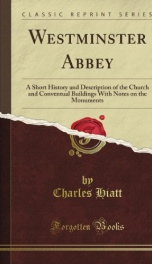westminster abbey a short history and description of the church and conventual

Kefore either pagan temple or Christian church was erected on it, the site of Westminster Ahbey was a place of marsh and forest. .From its dense thickets of thorn it derived its ancient name of Thorn Ey (the Island of Thorns), and its general character may be judged from the fact that in the nrst authentic charter granted to the Abbey it is called locus terrioilis-ihe terrible place.Thorney was about four hundred and seventy yards long and three hundred and seventy yards wide, being formed by the two branches of the Tyburn stream, which were joined on the west side by an artificial watercourse called the Long Ditch. On the east side was the river Thames, into which the two Tyburn streams flowed. The situation of the Abbey is not unlike that of Notre Dame at Paris, and nearly resembles that of Ely Cathedral. According to monastic tradition, the earliest building on the Isle of Thorns was a temple of Apollo, destroyed by an earthquake in a.d. 154. The temple is said to have been converTable of Contents I The Story of the Abbey 3; II The Abbey : Exterior 17; III The Interior 33; The Nave 33; The Transepts and Choir 42; The Choir and Choir Aisles 55; The Confessor's Chapel 64; The South Ambulatory and the Chapels of S Benedict,; S Edmund, and S Nicholas 77; The North Ambulatory and the Chapels of S Paul, S John; Baptist, S Erasmus, and Islip's Chapel 84; The Chapels of the North Transept 91; IV Henry VII's Chapel 97; V The Conventual Buildings 113; List of the Abbots and Deans of Westminster, and Table; of Chief Events in the History of the Abbey 127; General Dimensions of the Abbey Church 132; General Index 133; Index to Tombs and Monuments 135About the Publisher Forgotten Books is a publisher of historical writings, such as: Philosophy, Classics, Science, Religion, History, Folklore and Mythology.Forgotten Books' Classic R
Info about the book
Author:
Series:
Unknown
ISBN:
1112336060
Rating:
3/5 (1)Your rating:
0/5
Languge:
English
Users who have this book
Users who want this book
What readers are saying
What do you think? Write your own comment on this book!
write a commentif you like westminster abbey a short history and description of the church and conventual try:
Do you want to read a book that interests you? It’s EASY!
Create an account and send a request for reading to other users on the Webpage of the book!




